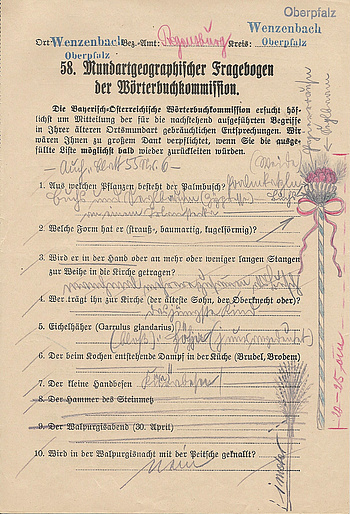Structure of the Dictionary and its Articles
The dictionary will be published in about ten to twelve volumes, each containing around 1700 columns. Three volumes and the digital index have already been printed (see Publications).
The vocabulary is published in alphabetical order, except for the compounds (e.g. [Mai]buschen) and prefix derivations (e.g. [ab]buschen), which follow directly on from the determinatum (example Buschen) and the simplex (e.g. buschen). This is partly for linguistic reasons, but also because the material has always been filed in this way.
Within the alphabetical sequence, the letters B- and P-, D- and T- and F- and V- are subsumed under B, D, F, because in most of Bavaria’s vernaculars they are pronounced identically and cannot always reliably be separated historically. Details of headword assignment, types of headwords and treatment of composite words, questions of the article order and reference structure are discussed in detail in the introduction to the Bayerisches Wörterbuch Volume 1.
The digital index of the Bayerisches Wörterbuch presents all recorded lemmas in index form. The directory is designed as a relational database that allows queries, gives results from the dictionary and offers links to the corresponding entries in the digitally stored volume.
Headword Selection
The dictionary documents the complete vocabulary of Bairisch-Bavarian dialects in Bavaria. It is not restricted to the vocabulary of the vernacular; colloquial and regional are also included.
Names of saints and first names are included as lemmas if they are of linguistic or folkloric interest, for example Abraham because of the idiom in Abrahams Wurstkessel (of a person as yet not born). Geographical names and surnames are excluded except when they illustrate the meaning of an appellative, as in the articles Ache ‘fließendes Gewässer’, Beunde ‘(eingezäuntes) Grundstück’.
Article Structure
Each article is corpus-based, which means it does not depict an assumed linguistic reality, but only and exclusively the dialect material collected for the project. This of course requires a comprehensive linguistic interpretation, starting with the assignment of the headword, which needs comprehensive knowledge of linguistic geography and language history. It is vital to know the grammar of the spoken language in order to recognise in which region the pronunciation Bīn means ‘Böden’ or ‘Bühne’, because this determines the choice of headword. Scientific and folkloric knowledge is also needed in order to record and describe the meanings correctly, for instance for tools, traditional customs, names of diseases and words that have a wide range of meanings, like Boden (floor, upper stock, attic …).
The articles are structured according to the different meanings of the word presented, see also the illustration on article structure in the first fascicle.

